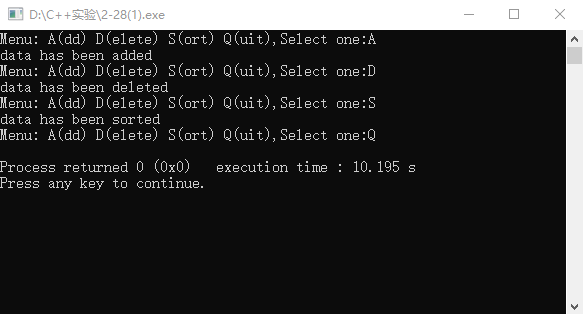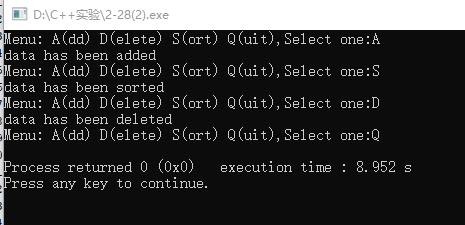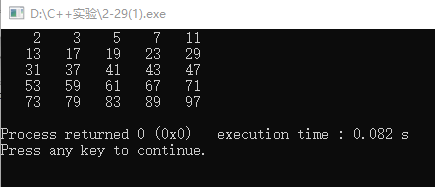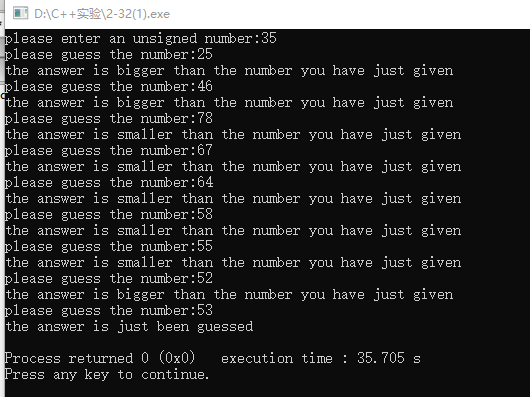实验内容:
2-28:实现一个简单的菜单程序,运行时显示“Menu:A(dd) D(elete) S(ort) Q(uit),Selete one:”提示用户输入。A表示增加,D表示删除,
S表示排序,Q表示退出。输入为A、D、S时分别提示“数据已经增加、删除、排序。”,输入Q时程序结束。
(1)要求使用if...else语句进行判断,用break,continue控制程序流程。
(2)要求使用switch语句。
下面是第一小问的解答:
1 #include <iostream> 2 #include <string.h> 3 using namespace std; 4 int main () 5 { 6 char a; 7 while(1) 8 { 9 10 cout<<"Menu: A(dd) D(elete) S(ort) Q(uit),Select one:"; 11 cin>>a; 12 if(a=='A') 13 { 14 cout<<"data has been added"<<endl; 15 continue; 16 } 17 else if(a=='D') 18 { 19 cout<<"data has been deleted"<<endl; 20 continue; 21 } 22 else if(a=='S') 23 { 24 cout<<"data has been sorted"<<endl; 25 continue; 26 } 27 else if(a=='Q') 28 { 29 30 break; 31 } 32 else 33 { 34 cout<<"no such choice concluded"<<endl; 35 continue; 36 } 37 } 38 return 0; 39 }

说一句题外话,原来在C语言中实现循环输入用的是while(scanf("%d",&n)!=EOF)或者scanf("%d",&n);while(n--),但是在C++里没有scanf()函数的用法,所以用while(1)来控制循环输入。
下面是第二个小问的解答:
1 #include <iostream> 2 using namespace std; 3 int main () 4 { 5 char a; 6 while(1) 7 { 8 cout<<"Menu: A(dd) D(elete) S(ort) Q(uit),Select one:"; 9 cin>>a; 10 switch(a) 11 { 12 case 'A': 13 { 14 cout<<"data has been added"<<endl; 15 continue; 16 } 17 case 'D': 18 { 19 cout<<"data has been deleted"<<endl; 20 continue; 21 } 22 case 'S': 23 { 24 cout<<"data has been sorted"<<endl; 25 continue; 26 } 27 case 'Q': 28 { 29 break; 30 } 31 default: 32 { 33 cout<<"no such choice concluded"<<endl; 34 continue; 35 } 36 } 37 if(a=='Q')break; 38 } 39 return 0; 40 }

2-29:用穷举法找出1~100间的质数并显示出来。分别使用while,do...while,for循环语句实现。
下面是第一个小问的解答:
1 #include <iostream> 2 #include <math.h> 3 #include<iomanip> 4 using namespace std; 5 int main () 6 { 7 int i=1,j,n=0; 8 while(i<=100) 9 { 10 for(j=2;j<=sqrt(i);j++) 11 { 12 if(i%j==0)break; 13 } 14 if(j>sqrt(i)&&i>1) 15 { 16 n++; 17 if(n%5==0) 18 cout<<setw(5)<<i<<endl; 19 else 20 cout<<setw(5)<<i; 21 } 22 i++; 23 } 24 return 0; 25 26 }

个人认为二三两小问于第一问的区别不大,只是把while()改成do...while()或者for()即可。
我在这里使用了math.h的头文件来使用求根sqrt()函数来提高效率,并用setw()来实现右对齐美化。
2-32:在程序中定义一个整型变量,赋以1~100的值,要求用户猜这个数,比较两个数的大小,把结果提示给用户,直到猜对为止。
1 #include <iostream> 2 #include <cstdlib> 3 using namespace std; 4 int main () 5 { 6 int thenumber; 7 int seed; 8 int guess; 9 cout<<"please enter an unsigned number:"; 10 cin>>seed; 11 srand(seed); 12 thenumber=rand()%100+1; 13 while(1) 14 { 15 16 cout<<"please guess the number:"; 17 cin>>guess; 18 if(guess>thenumber) 19 { 20 cout<<"the answer is smaller than the number you have just given"<<endl; 21 continue; 22 } 23 if(guess<thenumber) 24 { 25 cout<<"the answer is bigger than the number you have just given"<<endl; 26 continue; 27 } 28 if(guess==thenumber) 29 { 30 cout<<"the answer is just been guessed"<<endl; 31 break; 32 } 33 } 34 return 0; 35 }

原本我是自己设置的一个要猜的数,但是不能重复利用,所以用随机数和种子函数,先自己输入一个无符号整数作为种子,这样就能每次都生成不同的随机数。
值得注意的是系统生成的随机数是任意大小的但是题目只要求1-100的数,所以需要把它%100+1。do...while类似,把while改成do...while即可。
2-34:口袋中有红黄蓝白黑5种颜色的球若干个。没词葱口袋中取出3个颜色不同的球,问有多少种取法。
1 #include <iostream> 2 3 using namespace std; 4 int main () 5 { 6 int a=5,b=3,i,n,m,s; 7 n=a,m=b,s=b; 8 for(i=1;i<s;i++) 9 { 10 n--; 11 a=a*n; 12 } 13 //cout<<a; 14 for(i=1;i<s;i++) 15 { 16 m--; 17 b=b*m; 18 // cout<<m; 19 } 20 // cout<<b; 21 a=a/b; 22 cout<<a<<endl; 23 return 0; 24 }

这个只是求出不考虑顺序的取法总数,而且没有显示是哪几种取法。所以升级求考虑顺序且能显示是哪几种顺序的程序。
1 #include <iostream> 2 #include <iomanip> 3 using namespace std; 4 void swamp(int & ,int&); 5 void sperm(int color[],int,int ); 6 int sum; 7 int main () 8 { 9 int i,color[5],k,m; 10 for(i=0;i<=4;i++) 11 color[i]=i+1; 12 k=0; 13 m=5; 14 sperm(color,k,m); 15 cout<<endl; 16 cout<<sum<<endl; 17 18 return 0; 19 } 20 void swamp(int &a,int &b) 21 { 22 int t; 23 t=a; 24 a=b; 25 b=t; 26 } 27 void sperm (int color[],int k,int m) 28 { 29 int i; 30 if(k==3) 31 { 32 sum++; 33 for (i=0;i<=2;i++) 34 { 35 cout<<color[i]; 36 } 37 if(sum%5==0)cout<<endl; 38 else cout<<' '; 39 } 40 else 41 { 42 for(i=k;i<m;i++) 43 { 44 swamp(color[k],color[i]); 45 sperm(color,k+1,m); 46 swamp(color[k],color[i]); 47 } 48 } 49 }

这原本是个全排列算法,我是通过学习他人的程序得到的,但是这里不是全排列而是只要把5个中的3个进行排列,所以做了略微的调整,还有我用了数字1-5来代替颜色,进行优化可以用二维字符数组。
实验反思:
1.顺序,循环,条件语句的熟练掌握是学好编程的关键,刚开始不会可以通过模仿,之后自己总结开发出自己的程序设计。
2.swrt(),setw(),srand(),rand()等函数的掌握能让程序设计变得事半功倍,同时有美化作用。
3.对于枚举类型和字符数组的掌握还是不够,要多加练习。